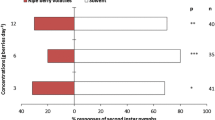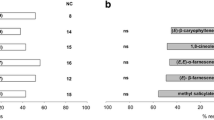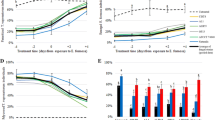Abstract
Adult granary weevils feeding on grain responded selectively to the volatile compounds of different strains of the entomopathogenic fungi Beauveria bassiana and Lecanicillium muscarium. The mycelium of B. bassiana strains had a repellent effect or a neutral effect with a tendency toward repellency. The response to L. muscarium strains varied from weak repellent (G-033) and neutral (Vl 49) to attractive one (Vl 21). Beauveria bassiana strain Bb 17 showed the highest virulence after beetles were sprayed with conidial suspension containing 1.0 × 108 spores / ml: the mortality of the beetles on the 7th day reached 74% with extensive mycelial growth over the dead beetles, LT50 was 5.6 days for this strain and 23 days for strain Bb 13. The L. muscarium strains showed low virulence, with the exception of strain G-033 (LT50 15.3 days), and they also formed mycelium on the dead insects. The granary weevil response should be considered when assessing the potential of entomopathogenic fungi. Beauveria bassiana strain Bb 17 was selected as a promising pest control agent, since neutral reaction of the granary weevil to its mycelium facilitates the spreading of fungal infection.
Similar content being viewed by others
REFERENCES
Ak, K., Efficacy of entomopathogenic fungi against the storedgrain pests, Sitophilus granarius L. and S. oryzae L. (Coleoptera: Curculionidae), Egypt. J. Biol. Pest Control, 2019, vol. 29, art. 12, p. 1. https://doi.org/10.1186/s41938-019-0115-y
Athanassiou, C.G., Kavallieratos, N.G., Vayias, B.J., Tsakiri, J.B., Mikeli, N.H., Meletsis, C.M., and Tomanović, Z., Persistence and efficacy of Metarhizium anisopliae (Metschnikoff) Sorokin (Deuteromycotina: Hyphomycetes) and diatomaceous earth against Sitophilus oryzae (L.) (Coleoptera: Curculionidae) and Rhyzopertha dominica (F.) (Coleoptera: Bostrychidae) on wheat and maize, Crop Prot., 2008, vol. 27, p. 1303.
Baverstock, J., Roy, H.E., and Pell, J.K., Entomopathogenic fungi and insect behaviour: from unsuspecting hosts to targeted vectors, BioControl, 2010, vol. 55, no. 1, p. 89.
Bojke, A., Tkaczuk, C., Stepnowski, P., and Gołębiowski, M., Comparison of volatile compounds released by entomopathogenic fungi, Microbiol. Res., 2018, vol. 214, p. 129.
Boucias, D.G., Lietze, V., and Teal, P., Chemical signals that mediate insect-fungal interactions, in Biocommunication of Fungi, Witzany, G., Ed., Dordrecht: Springer, 2012, p. 305.
Dromph, K.M. and Vestergaard, S., Pathogenicity and attractiveness of entomopathogenic hyphomycete fungi to collembolans, Appl. Soil Ecol., 2002, vol. 21, p. 197.
Gindin, G., Levski, S., Glazer, I., and Soroker, V., Evaluation of the entomopathogenic fungi Metarhizium anisopliae and Beauveria bassiana against the red palm weevil Rhynchophorus ferrugineus, Phytoparasitica, 2006, vol. 34, no. 4, p. 370.
Hussain, A., Tian, M.Y., He, Y.R., and Lei, Y.Y., Differential fluctuation in virulence and VOC profiles among different cultures of entomopathogenic fungi, J. Invertebr. Pathol., 2010, vol. 104, no. 3, p. 166.
Jacobsen, S., Eilenberg, J., Klingen, I., and Sigsgaard, L., Different behavioral responses in specialist and generalist natural enemy interactions (predators and fungi) in a strawberry–mite pest system, IOBC-WPRS Bull., 2015, vol. 109, p. 89.
Kaakeh, W., Reid, B.L., and Bennett, G.W., Horizontal transmission of the entomopathogenic fungus Metarhizium anisopliae and hydromethylnon among German cockroaches, J. Entomol. Sci., 1996, vol. 31, no. 4, p. 378.
Klinger, E., Groden, E., and Drummond, F., Beauveria bassiana horizontal infection between cadavers and adults of the Colorado potato beetle, Leptinotarsa decemlineata (Say), Environ. Entomol., 2006, vol. 35, p. 992.
Lord, J.C., Low humidity, moderate temperature, and desiccant dust favor efficacy of Beauveria bassiana (Hyphomycetes: Moniliales) for the lesser grain borer, Rhyzopertha dominica (Coleoptera: Bruchidae), Biol. Control, 2005, vol. 34, no. 2, p. 180.
Ludwig, S.W. and Oetting, R.D., Efficacy of Beauveria bassiana plus insect attractants for enhanced control of Frankliniella occidentalis (Thysanoptera: Thripidae), Fla. Entomol., 2002, vol. 85, p. 270.
Metchnikoff, I.I., Bolezni lichinok khlebnogo zhuka (Diseases of Wheat Grain Beetle Larvae), Odessa: Tipografiya P. Frantsova, 1879.
Meyling, N.V. and Pell, J.K., Detection and avoidance of an entomopathogenic fungus by a generalist insect predator, Ecol. Entomol., 2006, vol. 31, no. 2, p. 162.
Mitina, G.V., Selitskaya, O.G., and Chermenskaya, T.D., Attractiveness of phospholipids of the entomopathogenic fungus Lecanicillium lecanii to the western flower thrips Frankliniella occidentalis (Pergande) (Thysanoptera: Thripidae), Agrokhimiya, 2003, vol. 4, p. 69.
Mitina, G.V., Borisov, B.A., Pervushin, A.L., Choglokova, A.A., and Pavlyushin, V.A., The use of a Lecanicillium muscarium strain with insecto-acaricidal and antibiotic activity against sucking pests and fungal and bacterial diseases. RF Patent No. 2598251, date of priority 25.08.2015, 2016.
Mitina, G.V., Stepanycheva, E.A., and Petrova, M.O., The effects of volatile compounds of mycelium and extracts of entomopathogenic fungi on the behavioral response and viability of the western flower thrips Frankliniella occidentalis (Pergande), Parazitologiya, 2019, vol. 53, no. 3, p. 230.
Mohammed, A.A., Kadhim, J.H., and Hasan, A.M.H., Laboratory evaluation of entomopathogenic fungi for the control of khapra beetle (Coleoptera: Dermestidae) and their effects on the beetles fecundity and longevity, J. Agric. Urban Entomol., 2019, vol. 35, no. 1, p. 1.
Odinokov, V.N., Burov, V.N., Kukovinets, O.S., Ishmuratov, G.Yu., Shamshev, I.V., Selitskaya, O.G., and Zainullin, R.A., Semiokhemiki v zashchite zerna i produktov ego pererabotki ot vrednykh nasekomykh (Use of Semiochemicals for Protection of Grain and Grain Products from Insect Pests), Galin, F.Z., Ed., Ufa: Gilem, 2005.
Ormond, E.L., Thomas, A.P.M., Pell, J.K., Freeman, S.N., and Roy, H.E., Avoidance of a generalist entomopathogenic fungus by the ladybird, Coccinella septempunctata, FEMS Microbiol. Ecol., 2011, vol. 77, no. 2, p. 229.
Ortiz-Urquiza, A. and Keyhani, N.O., Action on the surface: entomopathogenic fungi versus the insect cuticle, Insects, 2013, vol. 4, no. 3, p. 357.
Pascual-Villalobos, M.J. and Robledo, A., Anti-insect activity of plant extracts from the wild flora in southern Spain, Biochem. Syst. Ecol., 1999, vol. 27, no. 1, p. 1.
Patocka, J., Bioactive Metabolites of Entomopathogenic Fungi Beauveria bassiana, Mil. Med. Sci. Lett., 2016, vol. 85, no. 2, p. 80.
Quintela, E.D. and McCoy, C.W., Conidial attachment of Metarhizium anisopliae and Beauveria bassiana to the larval cuticle of Diaprepes abbreviatus (Coleoptera: Curculionidae) treated with Imidacloprid, J. Invertebr. Pathol., 1998, vol. 72, p. 220.
Roy, H.E., Steinkraus, D.C., Eilenberg, J., Hajek, A.E., and Pell, J.K., Bizarre interactions and endgames: entomopathogenic fungi and their arthropod hosts, Annu. Rev. Entomol., 2006, vol. 51, p. 331.
Rumbos, C.I. and Athanassiou, C.G., Use of entomopathogenic fungi for the control of stored-product insects: can fungi protect durable commodities? J. Pest Sci., 2017, vol. 90, no. 3, p. 839.
Sabbour, M.M. and Abd El-Aziz, S.E., Efficacy of some bioinsecticides against Bruchidius incarnatus (Boh.) (Coleoptera: Bruchidae) infestation during storage, J. Plant Prot. Res., 2010, vol. 50, no. 1, p. 28.
Selitskaya, O.G., Gavrilova, O.P., Schenikova, A.V., Shamshev, I.V., and Gagkaeva, T.Yu., The effect of toxin-producing Fusarium fungi on behavior of the rice weevil Sitophilus oryzae (Coleoptera, Dryophthoridae), Entomol. Rev., 2014, vol. 94, no. 6, p. 820. https://doi.org/10.1134/S0013873814060037
Selitskaya, O.G., Mitina, G.V., Schenikova, A.V., Choglokova, A.A., and Levchenko, M.V., Effects of volatiles of entomopathogenic fungi on behavioral responses of storage pests, Vestn. Zashch. Rast., 2016, vol. 89, no. 3, p. 150.
Shafighi, Y., Ziaee, M., and Ghosta, Y., Diatomaceous earth used against insect pests, applied alone or in combination with Metarhizium anisopliae and Beauveria bassiana, J. Plant Prot. Res., 2014, vol. 54, no. 1, p. 62.
Staples, J.A. and Milner, R.J., A laboratory evaluation of the repellency of Metarhizium anisopliae conidia to Coptotermes lacteus (Isoptera: Rhinotermitidae), Sociobiology, 2000, vol. 36, no. 1, p. 133.
Teshome, A. and Tefera, T., Susceptibility of Sitophilus zeamais (Motsch.) (Coleoptera: Curculionidae) to Beauveria bassiana and Metarhizium anisopliae, Ethiop. J. Sci., 2009, vol. 32, no. 1, p. 21.
Thompson, S.R. and Brandenburg, R.L., Tunneling responses of mole crickets (Orthoptera: Gryllotalpidae) to the entomopathogenic fungus, Beauveria bassiana, Environ. Entomol., 2005, vol. 34, no. 1, p. 140.
Yanagawa, A., Yokohari, F., and Shimizu, S., The role of antennae in removing entomopathogenic fungi from cuticle of the termite, Coptotermes formosanus, J. Insect Sci., 2009, vol. 9, art. 6, p. 1.
Yanagawa, A., Fujiwara-Tsujii, N., Akino, T., Yoshimura, T., Yanagawa, T., and Shimizu, S., Odor aversion and pathogenremoval efficiency in grooming behavior of the termite Coptotermes formosanus, PLOS ONE, 2012, vol. 7, no. 10: e47412. https://doi.org/10.1371/journal.pone.0047412
Zakladnoy, G.A., Zashchita zerna i produktov ego pererabotki ot vreditelei (Protection of Grain and Grain Products from Pests), Moscow: Kolos, 1983.
Funding
This work was supported by the Russian Foundation for Basic Research (project 20-016-00241 A).
Author information
Authors and Affiliations
Corresponding author
Ethics declarations
The authors declare that they have no conflict of interest. All the applicable international, national, and/or institutional guidelines for the care and use of animals were followed. All the procedures performed in studies involving animals were in accordance with the ethical standards of the institution or practice at which the studies were conducted.
Rights and permissions
About this article
Cite this article
Mitina, G.V., Selitskaya, O.G. & Schenikova, A.V. Effect of Volatile Compounds of the Entomopathogenic Fungi Beauveria bassiana (Bals.-Criv.) Vuill. and Lecanicillium muscarium R. Zare et W. Gams on the Behavior of Sitophilus granarius (L.) (Coleoptera, Dryophthoridae) and Evaluation of the Virulence of Different Strains of These Fungi. Entmol. Rev. 100, 456–462 (2020). https://doi.org/10.1134/S001387382004003X
Received:
Revised:
Accepted:
Published:
Issue Date:
DOI: https://doi.org/10.1134/S001387382004003X




